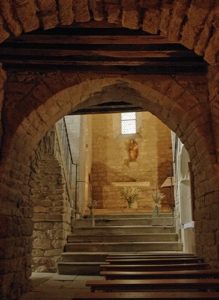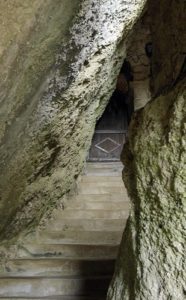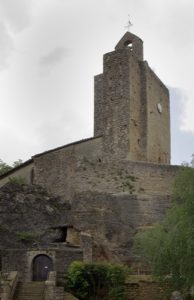Vals a small village in a delightful setting amongst fertile farmland. At the start of the village is a very large and splendid manor. There is a small square with well, marie and museum and a limited amount of parking.
Most people visit Vals for the sensational église rupestre, a semi rock church built on three levels. This is open daily between 9am-7pm, is free and receives a steady stream of visitors.
Église Santa Maria stands on a rock high above the village looking more like a castle keep than a church with its tall 14thC belltower with offset bell cote and wall around it.
The dramatic entrance is only the starter for what is to follow…
At the top of the square, steps lead up through the rock to a wooden door. Inside is a small piscina. The steps continue to climb up through a natural cleft in the rock to another wooden door. This opens into the pre-Romanesque 10thC church, which is often referred to as the ‘crypt’ which has modern wooden benches. It is carved out of the rock and has small ‘chapels carved out of the rock on either side. One contains a large round font.
Steps lead up into the narrow 11thC Romanesque chapel. The only light is from the east window which has a half trefoil top. A light switch on the north wall floods the area with artificial light. The chancel has a simple stone slab altar on a central support. At the east end below the window is a gilded statue of The Virgin Mary holding the Christ child. The floor is covered with terracotta tiles and the ceiling is ribbed. The ceiling, window arches and the arches of the recesses on the walls are covered with 12thC frescoes. These had been hidden by whitewash and only discovered 60 years ago. They are in predominant shades of dark blue, red and white with gold haloes. There is an image of Christ in Majesty with St Michael and St Matthew and archangels Gabriel and Raphael. To the left of the altar is a painting of the Annunciation. On the right is what is described as ‘bain de l’enfant Jesus’. This shows the figure of a child with arms outstretched with figures on either side. Above is a table set for a meal with a female figure to one side. In the centre of the chancel is a painting of the ‘college apostolique’ with four standing figures.
Two flights of stairs lead up to the 12thC nave built over the crypt and again partially excavated out of the rock. This has a pointed arch through which you look down onto the chancel. Above are traces of an earlier roof line. The walls are vaulted ceiling are plaster. The nave also has a terracotta tiled floor and wooden benches with backs. There are two locked wooden doors on the north and west walls. At the back wooden stairs lead up to a small gallery, the chapel of St Matthew at he base of the bell tower. Round topped windows with modern stained glass give plenty of light. They have images of St Loup and St George killing the dragon.
There is a small stone carved altar to the south of the arch. In front are black, grey and white tiles forming a star pattern. Diagonal carved pillars frame what looks like a death bed scene, with a haloed figure lying on the bed with a praying figure at his head and another haloed figure at his feet giving a blessing. Above is a small host box with a gilded door and cherub heads at the corners. Spirally carved pillars on either side support a carved arch with alpha and omega signs beneath.
This is a most unusual church and a very well worth while visit. The frescoes were a bonus.
Coming into the village from the east, parking is signed by a picnic area outside the village. There is a huge car park to the west.










